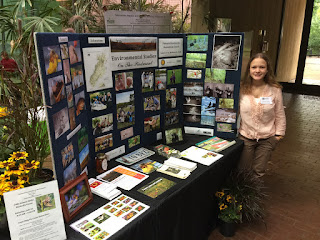Environmental Studies on the Piedmont visits the Zoo
Part of our mission is to connect people to the natural world and all of the wonderful learning that occurs there. Last weekend, we were invited to present at Conservation Science Day at the National Zoo. This was a fun day where we were able to get the word out about our programs and provide some interesting information to the public about a variety of topics including: creating habitats for salamanders, monitoring migrating birds, conducting annual butterfly counts, learning Native American values for the natural world and where to go to get a good education in conservation!
While there, Over a thousand people from all walks of life came through the great apes house and visited us despite the rain that day. Environmental Studies volunteers and students from the Integrative Studies program at George Mason including Melissa Fuerst, Nikki Jawadian and Kelsey Heath represented New Century College proudly.
Melissa showed off her research on our phenomenally successful, created vernal pool. The spotted and Jefferson salamanders, as well as wood frogs and tree frogs continue to do very well up there!
Nikki and Kelly worked with kids to teach them about what we learn from banding birds. Those that completed a puzzle were awarded with a band themselves! This was a great hit and wonderful opportunity for both students to work with children as they study to become teachers.
Nanette Mickle presented her new work on purple martins and the fascinating journeys they make migrating back and forth from Brazil. Everyone left with the desire to set up purple martin houses at their homes!
Anaya and Kathy Barrera talked with children about respect for the natural world and Native American values, encouraging everyone to get outside for a little while every day!
Some of the high school students received information about the Smithsonian Mason Semester and other courses offered through the Smithsonian Mason School of Conservation. There is no better way to become a conservation biologist than through our program at Mason!
Overall, we were happy for the opportunity to interact with the public and let them know what is going on at Environmental Studies on the Piedmont and Mason. As we pass the fall equinox and head toward shorter days our education programs and bird banding are in full swing! Thanks for tuning in and coming to see us on the field station!

























